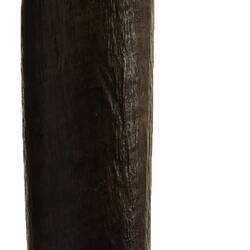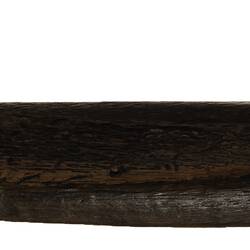Summary
'Before we had guns and traps and that, we used to make bundies, hunt with sticks, bundies. The only thing you needed with them was a strong arm and a good eye - if you didn't have those you went hungry. That goes right back. The art of making that throwing stick so that you got enough weight in it to get the distance and you got enough power to stun the rabbit while he was on the run.' Uncle Theo Saunders, Gunditjmara, 2010.
Men used the bundie as a throwing stick while hunting small and large game. It was made from a hardwood and carved while green, before being hardened over a fire or through applying lizard fat, which also made it waterproof and resulted in a glossy surface. The bulb fashioned at the top of the bundie acted as a counterweight, allowing for greater throwing distance. The carved concentric circles on the handle acted as a grip, to reduce the likelihood of slippage while throwing.
Local Name
Bundie
Physical Description
Wooden club with circular cross section and slightly curved. The handgrip is conical with deeply grooved rings around the shaft. The head is bulbous but otherwise undecorated. The shaft tapers from the centre to the ends. The club has been ochred.
Significance
The Gunditjmara peoples continue to have a strong social, cultural, and land management presence as the recognised traditional owners of a large area of western Victoria between the Wannon and Glenelg rivers. Aquaculture forms an integral part of their ancestral and contemporary identity and subsistence. The Gunditjmara people have continually fought for rights to their traditional country, winning landmark legal cases in both the 1980s and 2007.
In his speech at the native title consent determination in 2007, Gunditjmara Elder Uncle Ted Lovett highlighted the determination as a critical exercise in justice for his people;
'We have never been in any doubts as to the ownership of this beautiful place where our legends and stories were handed down by our Elders but today we will be told officially by the government that we are the native title holders. There are many people from this area who have died waiting for this day to come who wanted so much to hear these simple words 'this is your country', in recognition of who we are and where we come from. We know who these people are because they are our families. Today is a day of reckoning, of finally having what belongs to us. We Elders now have a legacy to leave to the coming generations of the Gunditjmara people in the future.'
More Information
-
Object/Medium
Club
-
Maker
-
Cultural Groups
-
Locality
-
Date Produced
-
Conservation
55 mm (Length), 50 mm (Width), 690 mm (Height)
-
Classification
-
Date Made
-
Maker
-
Clan/Language Group
-
Place Made
-
Indigenous Region
-
Keywords
-
Collection Names
-
Type of item
-
Discipline
-
Category
-
Collecting Areas



